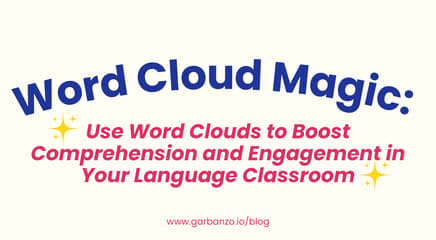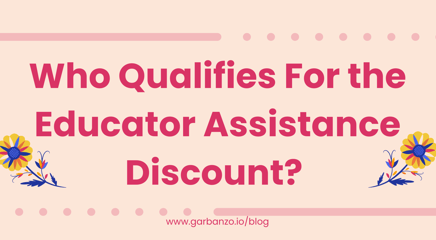Garbanzo is a web application designed to support language acquisition through reading and listening. Garbanzo primarily supports the following four learner profiles:
- Students learning Spanish as a new language who have an existing level of proficiency in English.
- Students studying Spanish as a heritage language, especially to develop literacy skills.
- Students learning English as a new language and have existing proficiency in any other language.
- Students developing English language literacy skills and have existing proficiency in English.
Because Garbanzo is first and foremost a tool for promoting language acquisition, it was strategically designed to align with research in the area of Second Language Acquisition (SLA); not research in the area of Literacy Development, popularly known as the Science of Reading. Even still, Garbanzo lessons are aligned with the Science of Reading in several important ways.
Would you rather have this blog post in ebook form?
Click the link below to sign up to have the ebook delivered right to your inbox!
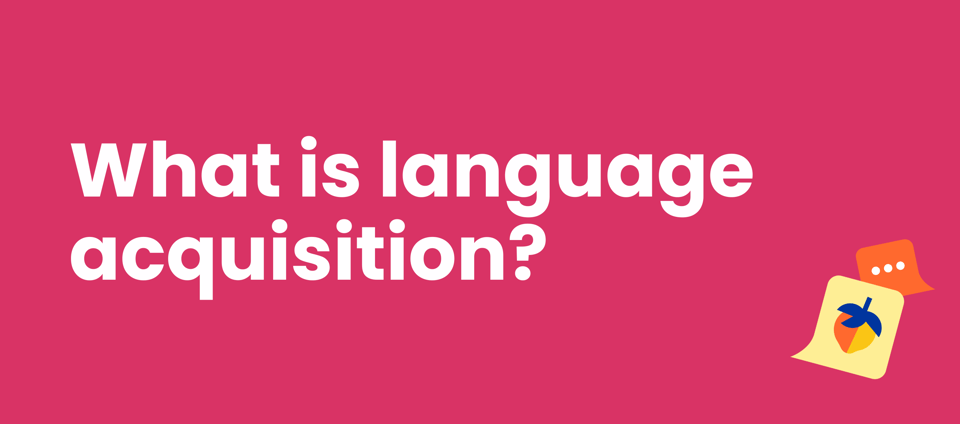
What is language acquisition?
Language acquisition is understood through a body of research from linguistics, psychology, and neuroscience that shows how people learn to understand and use language. Theories of language acquisition emphasize that language is a natural process; it is something that the brain is wired to acquire, unconsciously and automatically, through meaningful interaction and does not have to be taught.
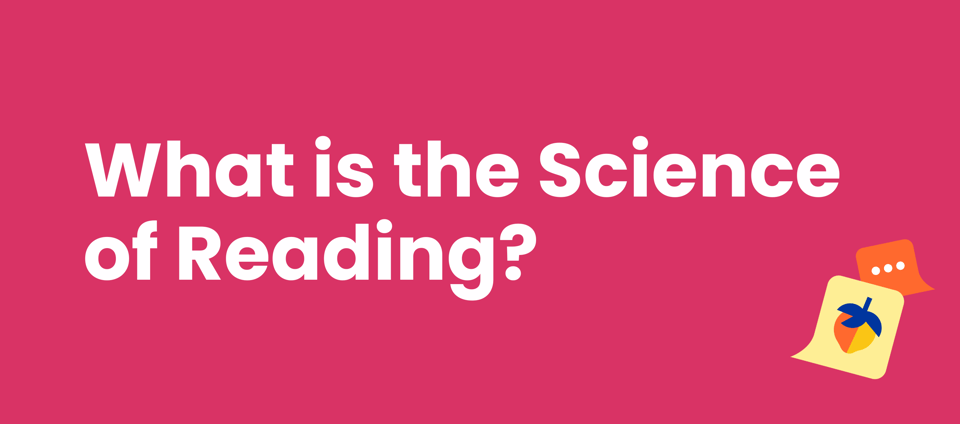
What is the Science of Reading?
The Science of Reading is a body of research from psychology, neuroscience, and education that shows how people learn to read. It emphasizes that reading is not a natural process; it is something that has to be taught.
Language is a natural process; it is something that the brain is wired to acquire through meaningful interaction and does not have to be taught. Reading is not a natural process; it is something that has to be taught.
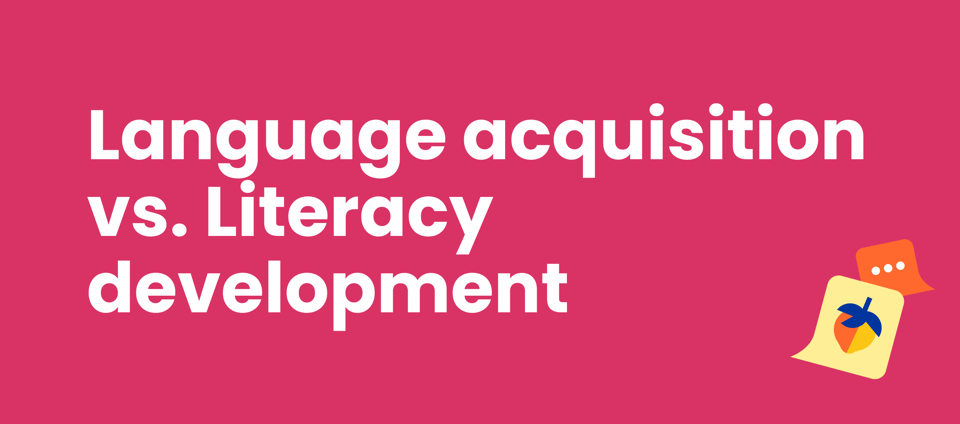
Language acquisition vs. Literacy development
These two bodies of research might seem at odds, because one states that reading must be taught and the other that language is naturally acquired. However, they reflect two different cognitive processes. Acquiring language is not the same as literacy development. Although both language acquisition and literacy development involve making meaning from language, they are fundamentally different processes with distinct paths, demands, and goals.
Acquiring language is not the same as literacy development. Reading and language are different cognitive processes.
Spoken language is a biologically-driven human capacity. The brain is wired to acquire language through exposure and interaction. Reading, however, is a cultural invention that builds on language but is not innate. Language is an innate capacity, while reading and writing are technologies.
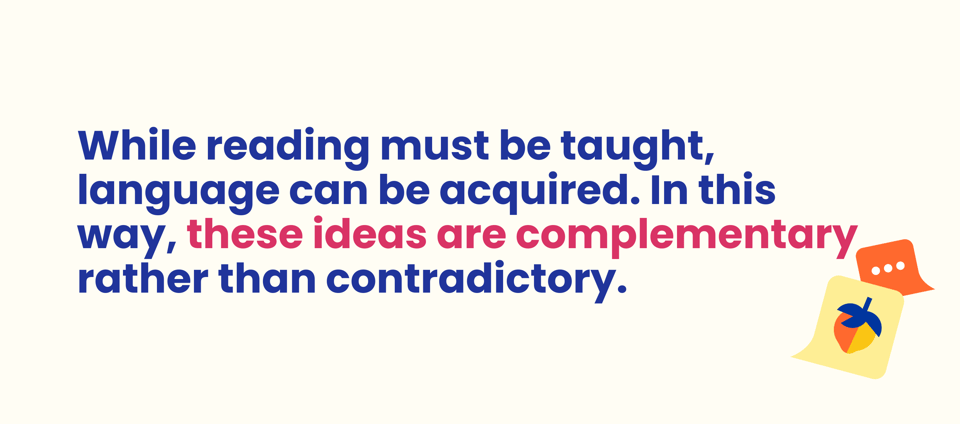
The Science of Reading shows that decoding written language requires explicit instruction because it maps symbols (letters) onto sounds and meaning, which is something our brains are not naturally programmed to do. In contrast, language acquisition research highlights how oral language develops naturally through communication. So, while reading must be taught, language can be acquired. In this way, these ideas are complementary rather than contradictory.
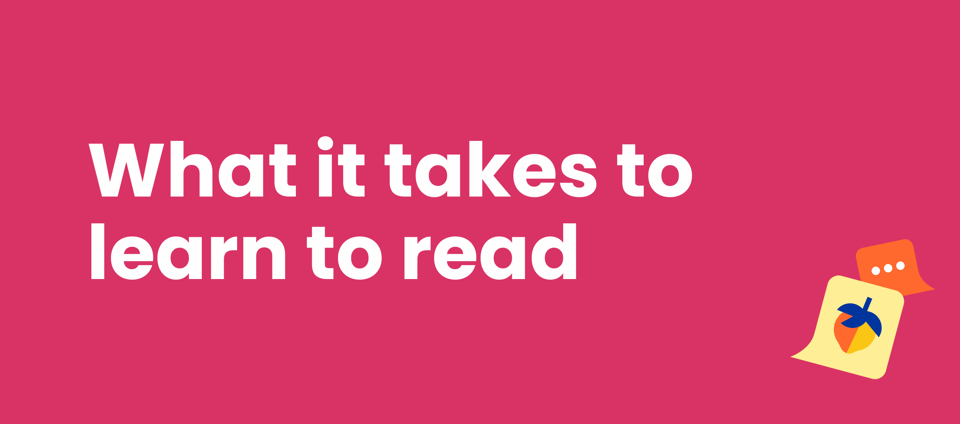
What it takes to learn to read
The National Reading Panel identifies five components of reading that are involved in meaning-making:
- Phonemic awareness: Recognizing and manipulating sounds in words.
- Phonics: Understanding the relationship between sounds and letters.
- Fluency: Developing the ability to read quickly and accurately.
- Vocabulary: Understanding the meaning of the words in a text.
- Comprehension: Understanding the messages conveyed through the text.
These components are always involved in teaching and learning to read, but instruction related to some components is sometimes more necessary than others.
Learning to read in a first language
The first step in learning to read is language development. Language development is related to the Vocabulary and Comprehension components of reading instruction, and it is something that happens before a person ever begins to learn how to read, and then it continues to develop alongside the components that are specific to reading. The key idea here is that learning to read in a first language typically builds upon a strong foundation of oral language… or what we could just call… language!!
Learning to read in a first language typically builds upon a strong foundation of oral language.
Students already know (understand) many of the words they are learning to read. They know the meaning of individual words, and they can understand words when they are strung together in phrases and sentences. Early readers can understand a broad range of vocabulary. In a book about a farm, for example, students already know the meaning of words like horse, cow, sheep, goat, duck, barn, hay, tractor… the list goes on forever! Students already know the meaning of many words in their first language, and so vocabulary development is not a strong focus of reading instruction.
However, students do not instinctively know how familiar words should appear on the page. Students need to develop phonemic awareness and phonics skills to be able to match familiar sounds to unfamiliar symbols. For that reason, developing phonemic awareness and phonics skills are the primary focus of early literacy development.
Learning to read in a new language
Learning to read in a new language is different. Students do not typically have a strong foundation of oral language, so they do not understand the meaning of words they are attempting to read in ‘found texts’. (Found texts, often referred to as authentic texts, are texts that are not written strategically for language learners. They refer to any text that a language learner might happen to pick up and attempt to read.) The components of Vocabulary and Comprehension are underdeveloped–or completely undeveloped–and so those components must be worked on either first; before the reading-specific skills of phonics, phonemic awareness, and fluency can be taught and practiced; or directly alongside the other components.
Early L2* readers have a very narrow range of vocabulary they can understand. Even simple vocabulary is unknown! In a book describing a house, for example, it does a student no good to be able to decode words like window, door, floor, roof, kitchen, living room, names of furniture, doorknob, staircase, etc. if they have no idea what those words mean.
*We use L2 to mean Second Language, and we use the term broadly to represent any additional language beyond the first.
For that reason, in classes for language learners, language acquisition must take priority over literacy development. Students must develop an internal linguistic system (which is a natural process) before they can develop literacy skills (which is an unnatural process). Without language in their heads, learners have nothing onto which the symbols on a page can be mapped. Although the two skills can develop alongside each other, language acquisition must lead the way. The symbol of a written word needs to be mapped onto sounds and meaning; without the sounds and meaning in the learner’s head, there is nothing in the mind to which the symbol can be connected.
Learning to read isn’t the same in every language
Learning to read doesn’t happen the same way in every language. This is because different languages have different relationships between the sounds we say and the letters we write.
Take Spanish, for example. Spanish is a very phonetic language, meaning that there’s a strong, consistent match between letters and sounds. If you know how each letter (or combination of letters) sounds, you can decode almost any Spanish word, even if you've never seen it before. Learning to decode is relatively straightforward in Spanish. For students learning to read in Spanish, very little direct instruction is needed in the areas of phonemic awareness and phonics.
English, on the other hand, is not so simple. English has what we call a deep orthography. That means the connection between spelling and pronunciation is much less predictable. For example, the "ough" in though, through, thought, and tough is pronounced four different ways! That means learning to read in English involves a lot more memorization, pattern recognition, and practice with irregular words. Students learning to read in English need significant instruction in the areas of phonemic awareness and phonics, whether they are already fluent in English or are developing English language proficiency alongside English language literacy.
So while children learning to read in Spanish might become fluent decoders very quickly, children learning to read in English often need more explicit instruction in phonics, word patterns, and irregular spelling rules to become confident readers. For that reason, children who are native speakers of Spanish typically become fluent readers at a young age (Seymour, 2003). Learning to read in Spanish, and other phonetic languages, is easy; relatively speaking. The phonetic nature of Spanish also contributes to a lower rate of dyslexia and other learning disabilities related to reading in Spanish-speaking children (Ziegler, 2005; López-Escribano et al., 2018).
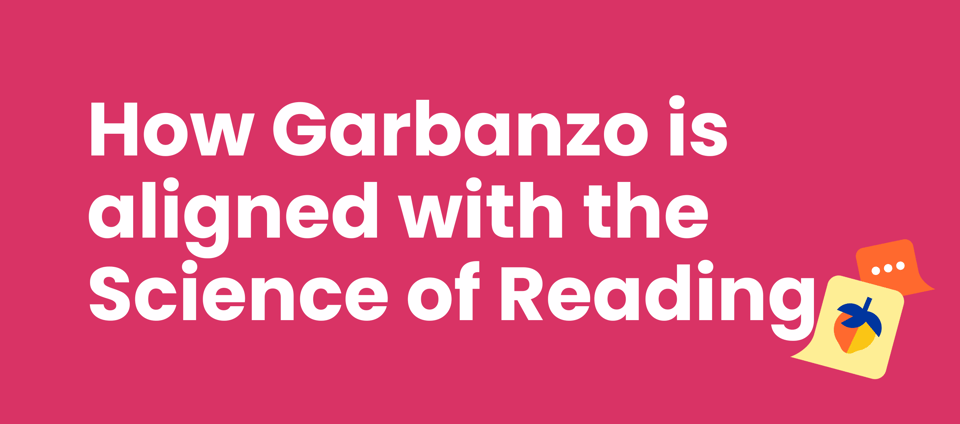
How Garbanzo is aligned with the Science of Reading
As a language development application, Garbanzo most explicitly supports literacy development in the areas of fluency, vocabulary, and comprehension, while also offering indirect support for phonics and phonemic awareness, especially for learners of English. These alignments are the result of purposeful design decisions rooted in what we know about how people acquire language and learn to read.
How Garbanzo develops vocabulary
Every Garbanzo text is written with a limited vocabulary range, using words that are carefully selected and repeated across lessons. We call this “sheltering vocabulary.” You can think of it like protecting students from words they don’t know! This intentional vocabulary sheltering ensures that students are not overwhelmed by unfamiliar terms and are able to make meaning from the text, which is essential for both comprehension and acquisition.
Research in both the Science of Reading and Second Language Acquisition underscores the importance of vocabulary for reading success. For learners to understand a text, they must understand the words within it. Garbanzo texts are typically written to be between 95–98% comprehensible (Nagy, Anderson, & Herman, 1987), making them highly accessible to learners and maximizing opportunities for vocabulary acquisition through reading. Vocabulary items are introduced, reinforced, and recycled through stories, informational texts, and engaging content.
How Garbanzo develops comprehension
Comprehension is supported in Garbanzo lessons through:
- Sheltered vocabulary, as described above;
- Repeated exposure to structures and words;
- Processing questions, which help students attend to meaning;
- Visual supports, such as illustrations and embedded media; and
- Contextualized content, presented in narrative or expository form.
These scaffolds help learners connect ideas and follow meaning throughout a text, even when their vocabulary is still developing. This mirrors the Science of Reading’s emphasis on background knowledge and language comprehension as critical components of reading development.
Bill VanPatten (2017) stated, “Comprehension does not guarantee acquisition, acquisition cannot happen without comprehension.” This principle holds true for reading as well: texts that students don’t understand cannot effectively build vocabulary, fluency, or linguistic proficiency.
“Comprehension does not guarantee acquisition, acquisition cannot happen without comprehension.”
How Garbanzo develops fluency
Fluency is the ability to read smoothly, accurately, and with appropriate expression; and it emerges from repeated encounters with readable, meaningful texts. Garbanzo supports fluency development through:
- Layered lesson formats, which provide repeated exposure to the same content in different forms;
- Short, scaffolded readings, which build stamina and confidence;
- Cumulative vocabulary, allowing students to read more efficiently over time; and
- Read-aloud audio recorded by native speakers, available with a Premium Subscription, which models fluent reading and allows students to follow along visually.
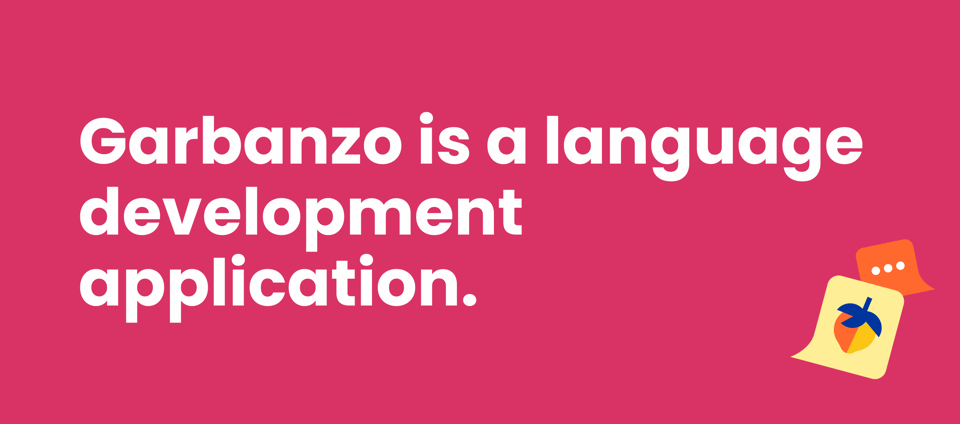
Garbanzo was designed first and foremost to support language development through acquisition. In doing so, it also supports the development of reading skills in powerful ways. By aligning intentionally with both the Science of Reading and research in Second Language Acquisition, Garbanzo meets learners where they are, whether they are developing foundational literacy, acquiring a new language, or doing both at once.
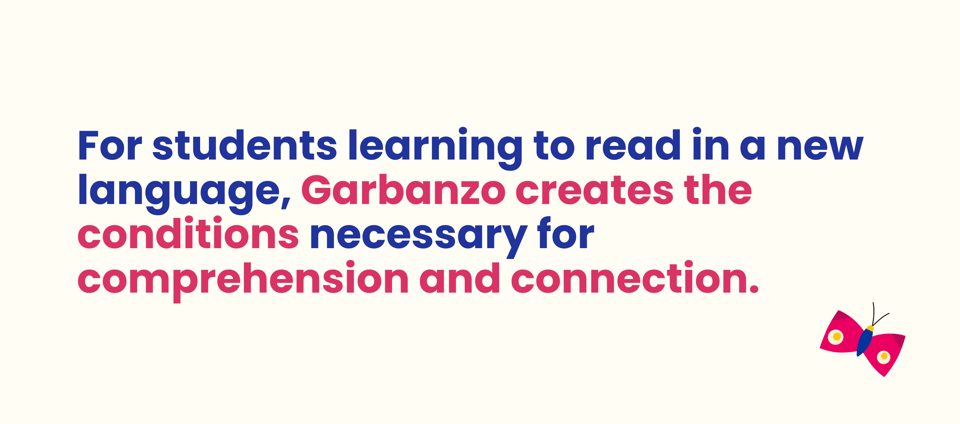
For students learning to read in a new language, Garbanzo creates the conditions necessary for comprehension and connection. It builds vocabulary through repeated exposure, supports fluency through leveled and engaging texts, and reinforces decoding and phonemic awareness through carefully integrated audio and phonics-focused lessons. Most importantly, it makes both language and literacy development accessible to all learners. All students are capable of acquiring language, and Garbanzo is made for all students!
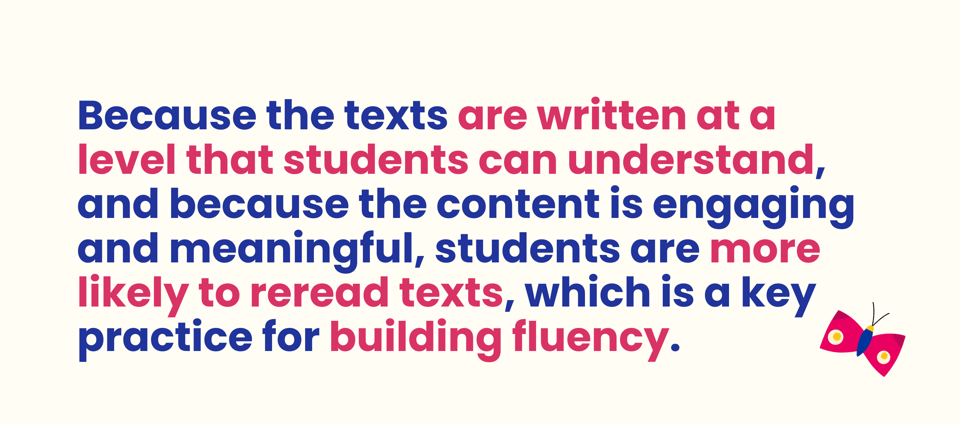
Because the texts are written at a level that students can understand, and because the content is engaging and meaningful, students are more likely to reread texts, which is a key practice for building fluency. The Biblioteca feature, which is also part of the Premium subscription, makes it easy for students to self-select and reread texts as often as they wish! The Premium subscription also allows teachers to print copies of Garbanzo texts, allowing for students to re-read the texts in class with a variety of purposes and in a different format.
How Garbanzo develops phonics skills
At the Premium Subscription level, Garbanzo offers professionally recorded audio for every lesson. Students can listen to the text as they read along on screen or with a printed version. This simultaneous listening and reading allows learners to observe how written words map onto the sounds they hear. While this is not a substitute for systematic phonics instruction, it provides a low-stress, meaningful context for reinforcing phonics skills; especially in highly phonetic languages like Spanish.
In English, where decoding is less predictable due to irregular spelling patterns, Garbanzo takes phonics support one step further. Garbanzo English includes a dedicated series of phonics-focused lessons, each centered on a specific spelling pattern. These lessons provide learners with repeated exposure to common letter-sound combinations in context, reinforcing phonics through engaging content. For example, a lesson might focus on the “-ight” pattern (as in “light,” “night,” and “bright”), or the long “a” spelled “ai” (as in “rain” and “train”).
This makes Garbanzo English a particularly helpful tool for students developing both English language proficiency and English literacy, including Newcomer MLLs.
How Garbanzo develops phonemic awareness
Like phonics, phonemic awareness is not the primary instructional target of most Garbanzo lessons, but it is supported, particularly through the audio features in the Premium Subscription. As students listen to the same text multiple times, they begin to notice, differentiate, and manipulate sounds, especially when paired with guided listening or follow-up activities.
The phonics-focused series in Garbanzo English also plays a role in developing phonemic awareness, since each lesson includes multiple examples of the same sound pattern, presented both visually and aurally. By focusing on a sound and its related spellings, learners begin to recognize sound units within words and strengthen their ability to decode unfamiliar words.
For students developing literacy in English (which is a language with a deep orthography!), teachers may choose to supplement Garbanzo reading with explicit instruction in phonemic manipulation, but Garbanzo’s audio-rich environment lays an important foundation.
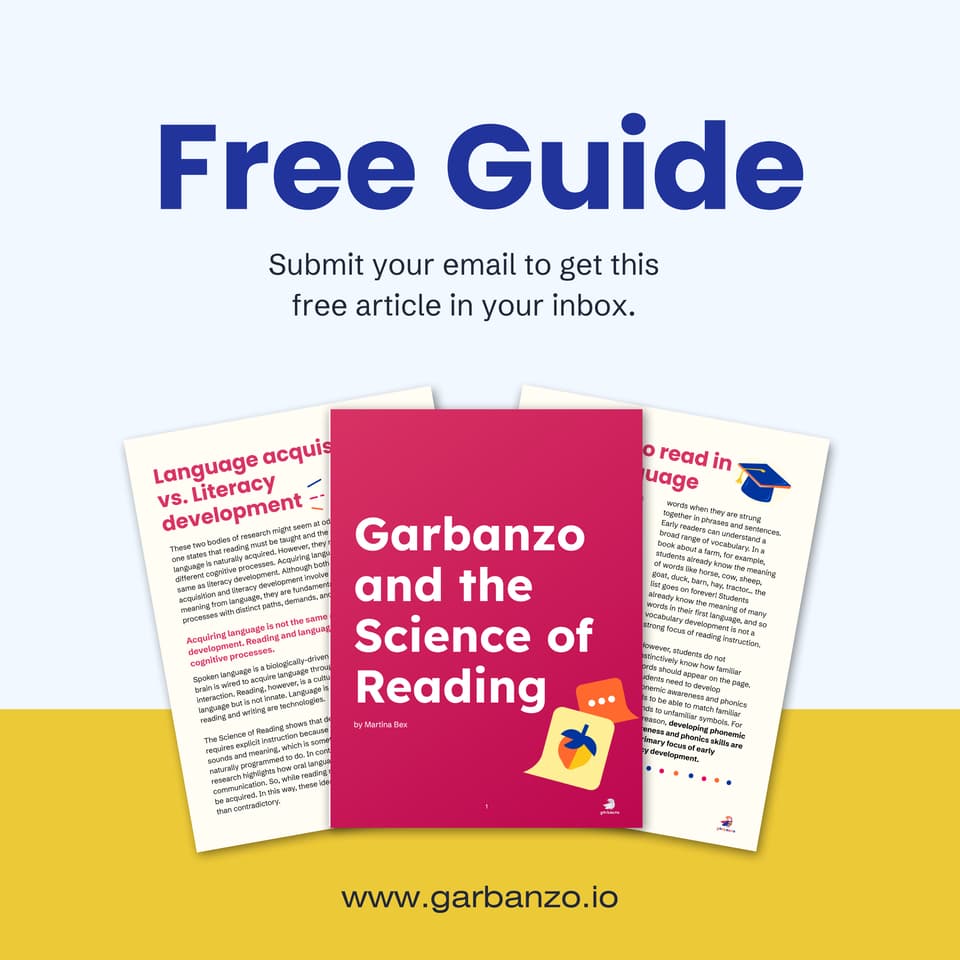
Download the FREE ebook, "Garbanzo and the Science of Reading!"
Download our free ebook to learn:
- The difference between language acquisition and literacy development (the two are actually complementary!)
- Why the Science of Reading matters and how it applies to Garbanzo curriculum in a way that YOU can use.
- The 5 key elements that are REQUIRED for a student to learn to read – and the difference between learning to read in a first language and a new language.
- How you can strategically build an environment designed to help students acquire target language reading skills with more ease.

References
Jiménez, J. E., Rodríguez, C., & Ramírez, G. (2009). Spanish developmental dyslexia: Prevalence, cognitive profile, and home literacy experiences. Journal of Experimental Child Psychology, 103(2), 167–185. https://doi.org/10.1016/j.jecp.2009.02.004
López-Escribano, C., Suro Sánchez, J., & Leal Carretero, F. (2018). Prevalence of developmental dyslexia in spanish university students. Brain Sciences, 8(5), 82. https://doi.org/10.3390/brainsci8050082
Seymour, P. H., Aro, M., & Erskine, J. M. (2003). Foundation literacy acquisition in European orthographies. British Journal of Psychology, 94(2), 143–174. https://doi.org/10.1348/000712603321661859
Soriano, M. F., & Miranda, A. (2010). Developmental dyslexia in a transparent orthography: A study of Spanish dyslexic children. Advances in Learning and Behavioral Disabilities, 23, 173–192. https://doi.org/10.1108/S0735-004X(2010)0000023011
VanPatten, B. (2017). While we’re on the topic: BVP on language, acquisition, and classroom practice. The American Council on the Teaching of Foreign Languages.
Ziegler, J. C., & Goswami, U. (2005). Reading acquisition, developmental dyslexia, and skilled reading across languages: A psycholinguistic grain size theory. Psychological Bulletin, 131(1), 3–29. https://doi.org/10.1037/0033-2909.131.1.3


